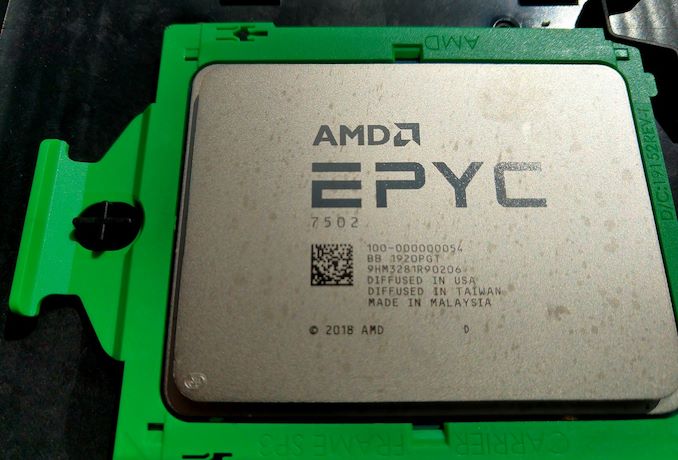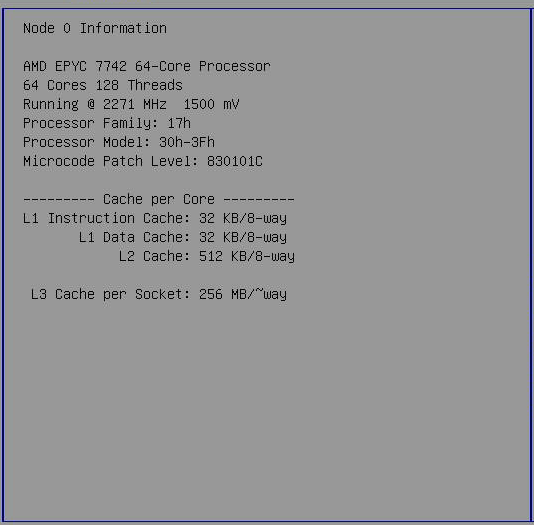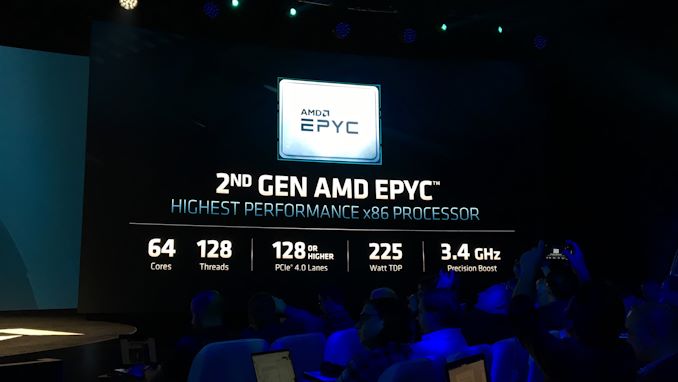AMD Rome Second Generation EPYC Review: 2x 64-core Benchmarked
by Johan De Gelas on August 7, 2019 7:00 PM EST
If you examine the CPU industry and ask where the big money is, you have to look at the server and datacenter market. Ever since the Opteron days, AMD's market share has been rounded to zero percent, and with its first generation of EPYC processors using its new Zen microarchitecture, that number skipped up a small handful of points, but everyone has been waiting with bated breath for the second swing at the ball. AMD's Rome platform solves the concerns that first gen Naples had, plus this CPU family is designed to do many things: a new CPU microarchitecture on 7nm, offer up to 64 cores, offer 128 lanes of PCIe 4.0, offer 8 memory channels, and offer a unified memory architecture based on chiplets. Today marks the launch of Rome, and we have some of our own data to share on its performance.
Review edited by Dr. Ian Cutress
First Boot
Sixty-four cores. Each core with an improved Zen 2 core, offering ~15% better IPC performance than Naples (as tested in our consumer CPU review), and doubled AVX2/FP performance. The chip has a total of 256 MB of L3 cache, and 128 PCIe 4.0 lanes. AMD's second generation EPYC, in this case the EPYC 7742, is a behemoth.
Boot to BIOS, check the node information.
[Note: That 1500 mV reading in the screenshot is the same reading we see on consumer Ryzen platforms; it seems to be the non-DVFS voltage as listed in the firmware, but isn't actually observed]
It is clear that the raw specifications of our new Rome CPU is some of the most impressive on the market. The question then goes to whether or not this is the the new fastest server chip on the market - a claim that AMD is putting all its weight behind. If this is the new fastest CPU on the market, the question then becomes 'by how much?', and 'how much does it cost?'.
I have been covering server CPUs since the launch of the Opteron in 2003, but this is nothing like I have seen before: a competitive core and twice as much of them on a chip than what the competition (Intel, Cavium, even IBM) can offer. To quote AMD's SVP of its Enterprise division, Forrest Norrod:
"We designed this part to compete with Ice Lake, expecting to make some headway on single threaded performance. We did not expect to be facing re-warmed Skylake instead. This is going to be one of the highlights of our careers"
Self-confidence is at all times high at AMD, and on paper it would appear to be warranted. The new Rome server CPUs have improved core IPC, a doubling of the core count at the high end, and it is using a new manufacturing process (7 nm) technology in one swoop. Typically we see a server company do one of those things at a time, not all three. It is indeed a big risk to take, and the potential to be exciting if everything falls into place.
To put this into perspective: promising up to 2x FP performance, 2x cores, and a new process technology would have sounded so odd a few years ago. At the tail end of the Opteron days, just 4-5 years ago, Intel's best CPUs were up to three times faster. At the time, there was little to no reason whatsoever to buy a server with AMD Opterons. Two years ago, EPYC got AMD back into the server market, but although the performance per dollar ratio was a lot better than Intel's, it was not a complete victory. Not only was AMD was still trailing in database performance and AVX/FP performance, but partners and OEMs were also reluctant to partner with the company without a proven product.
So now that AMD has proven its worth with Naples, and AMD promising more than double the deployed designs of Rome with a very quick ramp to customers, we have to compare the old to the new. For the launch of the new hardware, AMD provided us with a dual EPYC 7742 system from Quanta, featuring two 64-core CPUs.












180 Comments
View All Comments
wrkingclass_hero - Sunday, August 11, 2019 - link
What does AMD have to do to get a Gold or Platinum recommendation?oRAirwolf - Thursday, August 15, 2019 - link
This is a good questionimaskar - Sunday, August 11, 2019 - link
Single thread performance is very important for those who lives in cloud. A quick example: suppose I provision 2 core/4gig vm (this is of course hyperthreads). And on AWS I have a choice - m5 and m5a, where AMD is cheaper. What do I sacrifice? Not really throughput, because you don't run your prod workloads at 100% CPU. But there is the latency. If those cores clocked lower, I would get the same amount of responses, but slower. And since in microservice world you have a chain of calls, you get this decrease 10 times. Is it worth it?That was the case for 1st gen EPYC. Would 2nd gen have latency parity?
notashill - Sunday, August 11, 2019 - link
It's hard to say until the cloud instances actually launch.The current m5a instances are using a custom SKU which is clocked at 2.5GHz max boost.
Rome's IPC is ~15% higher and clock speeds are all around higher so single threaded performance should be quite a bit better, but ultimately the exact numbers will depend on which SKUs the cloud vendors decide to use and how high they clock.
duploxxx - Tuesday, August 13, 2019 - link
did you actually ever work with hypervisors?there are other things than raw clock speed.... its all about scheduling and when there are more cores / socket available the scheduling is more relaxed, less ready time..... EPYC generation 1 is already awesome for hypervisor way better choice than most Intel counter parts for sure if you look at socket cost... but than again I am probably talking to a typical retard ****
JoeBraga - Wednesday, August 14, 2019 - link
Can you Explain better? But the license isn't bought by the quantity of coresor Per socket?imaskar - Wednesday, August 14, 2019 - link
He probably talks about VmWare, which is licensed per socket, not per core. So with EPYC gen2 you need twice less licenses for the same cloud capacity (assuming cores are equal).JoeBraga - Wednesday, August 14, 2019 - link
Now I understoodimaskar - Wednesday, August 14, 2019 - link
Rather than calling others retards, you could first dig a little deeper into an issue. No, I don't work with hypervisors directly, I'm from the other side. I write software and I want good latency (not insane one like for HFT, but still a good one). Because for throughput we could just spin one more instance. You can't buy latency horizontally.I'm not taking numbers out of the blue. There is a benchmark for AMD instances vs Intel instances on AWS. I'm not sure if we are allowed to post links to other resources here. Put this string into Google and you will surely find it: "A Look At The AMD EPYC Performance On The Amazon EC2 Cloud". Despite this article being very enthusiastic about those instances, you can really see that per core performance on Intel is better, meaning better latencies for web apps.
I will probably write my own set of benchmarks, because that one seems to completely ignore web servers. I am very enthusiastic about AMD instances, but they are definitely not a no-brainer.
quadibloc - Tuesday, August 13, 2019 - link
The new Ryzen chips compete well with what Intel is currently producing. But while they doubled AVX 2 support, so as to match what Intel has, Ice Lake will double that - as has been known for some time. So if this is what AMD thought would be competitive with Ice Lake, as Forrest Norrod said, AMD was not trying hard enough - and they're just lucky Ice Lake was late. AMD's position relative to Intel with its previous generations of Ryzens seems to be the limit of their ambitions. Combine that with Intel reacting to its current issues, and it looks to me that AMD will have to rethink some aspects of its strategy to avoid Intel being ahead when it comes time for next year's chips from both companies.